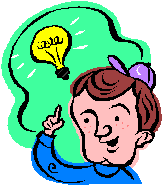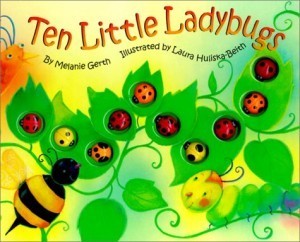Kimberly Scanlon's Blog, page 4
October 1, 2014
A Toddler Pumpkin Book to Build Language: It’s Pumpkin Day, Mouse!
A Toddler Pumpkin Book to Build Language: It’s Pumpkin Day, Mouse!
It's Pumpkin Day, Mouse! (If You Give...) ">
">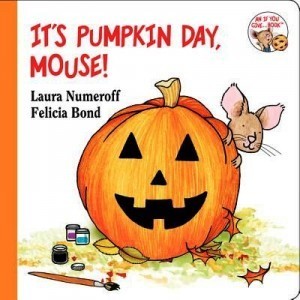
*Amazon affiliate links are included in this post AND FREEBIES…read to the end!
With Halloween right around the corner, I decided to get my act together and write a post on a favorite Halloween themed book for toddlers (preschoolers like it too). Before I share how to use this book to encourage speech and language skills, here’s a little Halloween fun fact:
Did you know that the jack-0-lantern tradition began in Ireland hundreds of years ago? Back then the Irish carved turnips or potatoes into jack-0-lanterns. It wasn’t until many Irish immigrated to America and discovered that they could use pumpkins instead!
…I didn’t know this and I’m part Irish!
Here’s my quick summary of It’s Pumpkin Day, Mouse!  :
:
It’s about a very well-known mouse (you know this mouse if you’ve read other books from Numeroff’s series) who decorates 7 different pumpkins. He draws facial expressions on the pumpkins to depict various emotions. While doing so, mouse makes a mess! Typical. He likes to do that. It’s a super cute, short story that has a beginning, a middle, and an end.
As a parent I like this book because:
It can be read while your child is relaxed and focused. Based on an informal survey with my parents, I found that parents typically read to their children when they are calm and or want to calm them down. Often times this is just before they go to sleep. Reading is viewed an intimate and cherished activity and it’s part of a daily routine.
As an SLP I like this book because there are many opportunities to elicit speech and language. It’s also easy to do an extension activity and then reference back to the book without boring the child.
Here are examples of sounds, words, and word combinations that may be targeted during a “reading session”.
For toddlers who are not yet talking, your child can try to imitate silly sounds.
For toddlers who have started imitating sounds and some words, try increasing their vocabulary by targeting some of the following words:
Tip: According to research by the First Words Project, a model early identification and intervention program out of the department of Communication Disorders at Florida State University, “Knowing how to use objects helps children learn the names of objects. Many of the most common first words are names for objects that the child uses.” Please keep this in mind when you think of words to target.
To encourage your toddler to combine words, expand and extend the single words that are already in his or her repertoire. I have included some examples BUT remember to build off words that he or she is already saying.
Note – Many of the adjectives (aka describing words) here are some universal emotions that all humans feel. Identifying and recognizing emotions helps toddlers to later develop emotional self-regulation skills. May be good to to emphasize feelings if you have a toddler who gets frustrated and or pinches and bites.
Extension Activities:
Life gets busy. You get busy. Keep it simple.
I created a pumpkin worksheet that I did with my daughter.
Here’s what we did:
First, Kerrigan colored the pictures (print FREEBIE in black and white).
This was the extent of her coloring…ha! Some toddlers like to color some do not.
She really liked telling me what faces to draw (see word combinations above). She likes telling what to do.
Before and after I drew each face, I pointed to the pictures in the book so she made the connection between the book and our activity.
We ended on making the different facial expressions ourselves (example, show me happy, show me sad, show me etc). This was a lot of fun!
Grab my FREE It’s Pumpkin Day, Mouse! Handout and Worksheet (includes directions, explanations, and pumpkins) by clicking HERE. Feel free to share with clients, family and friends. Just don’t copy it and call it your own. Thanks!
Have a preschooler? Want to read another cute Halloween themed book while enhancing his or her language and literacy skills? Please check out my other post.
Playing with Words and Sublime Speech also have some fantastic Fall/Halloween themed book recommendations.
Have fun and have a very happy Halloween!
In need of some additional free and helpful resources? Please subscribe to my newsletter. I share information and handouts exclusively with my newsletter subscribers.
If you have enjoyed reading My Toddler talks, please help spread the word. Tell your friends, write an honest review on Amazon, click the social media buttons or personally give me your feedback. I love hearing from my readers and value your input.
Thanks for reading!
The post A Toddler Pumpkin Book to Build Language: It’s Pumpkin Day, Mouse! appeared first on My Toddler Talks.
September 25, 2014
A Toddler Book to Build Language: Do You Wear Diapers?
A Toddler Book to Build Language: Do You Wear Diapers?
Recently, I had the awesome opportunity to guest post for Dr. Carole Zangari, professor of speech language pathology and creator of the informative website PraAACitcal AAC. Dr. Zangari has been involved in the practice and teaching of Augmentative and Alternative Communication (AAC) for over 20 years.
The American Speech-Language-Hearing Association provides the following description of AAC:
Writing for Dr. Zangari was an honor.
In my post, I wrote about how to build language and emergent literacy using an incredibly fun board book, Do You Wear Diapers? by Tanya Roitman.
by Tanya Roitman.
If you’re looking for a unique book and are interested in learning how to adapt one, click here to find out!
While you’re visiting PrAACtical AAC be sure to read her other posts too!
Enjoy!
The post A Toddler Book to Build Language: Do You Wear Diapers? appeared first on My Toddler Talks.
September 1, 2014
Speech Therapy for Toddlers: 7 Ways to Promote Communication without Frustration
Speech Therapy for Toddlers: 7 Ways to Promote Communication without Frustration
So, you’re a parent or a speech language pathologist (SLP) who is new to early intervention and have tried implementing some of the following communication elicitation strategies:
BUT, instead of your toddler communicating – he cries, runs away from you, shuts down, or even pinches and bites.
Photo Credit: adwriter
If this is happening, maybe I can help.
Many times these tears and tantrums are do to -
PRESSURE!
Hope you’re channeling Billy Joel right now.
You’re putting too much pressure on yourself and too much pressure on the child.
Here are 7 ways to reduce pressure and promote communication without frustrating your toddler:
Change your mindset.
If you’re an SLP treating a child who is delayed, I’m sure you’ve felt pressure to get a child talking almost immediately. You want to prove to parents that this early intervention thing is worth their time and money and you also want to provide efficient and effective treatment.
Sometimes though, this thinking backfires and causes way too much stress.
We should be relaxed, be able to take a few deep breaths, be smiling, and of course, even be laughing during our sessions.
Think – This should feel and look fun!
When I leave for work my husband sometimes kiddingly says, “Have fun!”Although this kinda gets my goat (and he knows it) I strongly believe that speech therapy with toddlers should be FUN.
If YOU’RE thinking this is NOT fun, then 10 to 1 the child thinks it’s not fun either.
Keep yourself in check by asking yourself:
How’s my breathing?
Am I having fun?
Is the child having fun?
If not, how can I change this so we are both having fun?
When young children are having fun, they’re comfortable and more likely to communicate.
2. Accept quiet times or quiet moments.
There will be times when your little one is just quiet.
Often times children are quiet when they are learning and processing new information. In my experience children are usually very quiet when introduced to a new activity or toy.
That’s okay! Continue to have fun and keep using your communication elicitation strategies.
Don’t be surprised though when the next time you re-introduce that toy or activity, he or she blurts out a new word!
3. Reset expectations.
I need to lose some weight and I want to see results immediately. In fact I want to see results instantaneously. Weight loss doesn’t happen like that though. Speech therapy is the same way.
It’s a marathon not a sprint.
Trust that your child can and will learn to communicate. It may not happen now, it may not happen tomorrow, but it will happen.
4. Play. Play. Play.
If your child is showing signs of frustration, follow his lead and let him play how he wants to play. Forget about your own plans and abandon any play routines you may have started.
Play how he wants to play.
Take turns in his play and expect nothing.
Aim for building rapport or seek out calmness and peacefulness – those go a long way.
5. Engage the whole child.
When you have achieved that peacefulness, then start where you know the child can and will succeed.
Many times, this entails engaging the whole child.
For instance, if the child can’t say “frog”then have him sign frog.
Get him to sign frog with increased frequency and confidence. And, have him to do it whenever it’s appropriate.
If your child is not producing the sign for frog and can’t verbally say “frog”, then get him to imitate a larger gross motor movement.
Hop around the house like a frog and see if your child will too!
Still say the word “frog”or “ribbet” or “hop”or any word related to what you’re doing.
Many times it’s easier for a child to imitate a larger, gross movement than a smaller, fine movement.
Accordingly, “When language is combined with movement, learning increases 90 percent.” (Moyses)
6. Slow down!
When eager to see change or progress, we speak and move faster than we think. This puts undue pressure on the child as well as ourselves.
Children process language much slower than adults and children with delays often process auditory information (like spoken speech) even slower.
Thus, slow down your rate of speech and add in pauses.
When you slow down your rate of speech, you’ll find that you also slow down your physical movements.
When you slow down your physical movements, you are taking off pressure and, for lack of better words, chilling out a bit.
Slow down and chill out a bit.
7. Find the threshold.
Pediatric speech language pathologists who specialize in working with toddlers have a knack for making speech therapy sessions look fun and easy.
We skillfully know how to engage toddlers, keep their attention and motivation, as well as get them to respond, imitate and or initiate communication. Many of us are also very good at coaching and empowering parents to use certain techniques. Sometimes we’re so good that to the unknowing person, it may seem…easy…
….don’t be fooled!
We’re constantly adjusting, adapting, and manipulating situations to make the toddler feel in control and at ease while still targeting a specific goal.
How come a good speech therapy session looks so fun and so easy?
Because most of the time we know just how much to push, encourage, or challenge the toddler to make progress BUT to avoid a meltdown.
Through calculated discovery (or simple trial and error – ha!) we find the child’s tolerance or stress threshold and work with it.
Finding a child’s threshold- how much to push and how far to go- is something of an art and also something that is unpredictable.
Every child’s threshold is different.
Every child is also a little different each day, so his or her threshold may change.
Therefore even experienced SLPs may end up having a toddler crying or shutting down during a session. This can be expected sometimes. However, it shouldn’t be happening all the time.
The majority of time should be spent having fun and communicating!
Finding the threshold may be tricky.
My rule of thumb – push or press a little, watch for any distress and then retreat or pull back a little BEFORE pushing and pressing some more.
If I treat a child and he or she hits a wall, I take it to mean that I pushed too far. I need to take a step back because I did too much too soon.
Effective speech therapy with toddlers is fun, but it’s also a balancing act.
You need to push or press your toddler or manipulate a variable to see progress but you shouldn’t push too far that you are causing a meltdown or shutdown.
As always, I hope this post has been helpful!
In need of some additional free and helpful resources? Please subscribe to my newsletter. I share information and handouts exclusively with my newsletter subscribers.
If you have enjoyed reading My Toddler talks, please help spread the word. Tell your friends, write an honest review on Amazon, click the social media buttons or personally give me your feedback. I love hearing from my readers and value your input.
Thanks for reading!
References:
Moyses, K. (2012, May 30). Movement can increase learning in children.Retrieved from http://msue.anr.msu.edu
The post Speech Therapy for Toddlers: 7 Ways to Promote Communication without Frustration appeared first on My Toddler Talks.
August 3, 2014
My Toddler Pinches and Bites When We Try to Get Her To Talk
My Toddler Pinches and Bites When We Try to Get Her to Talk.
Photo Credit: bradleygee
Several posts back I wrote:
Why does my Toddler Pull and Point But Not Talk? and 8 Ways to Get Your Toddler to Communicate
These two posts were in response to an email from a My Toddler Talks reader asking how to encourage her toddler to communicate with words rather than pulling and pointing.
A few weeks ago, another My Toddler Talks reader emailed with the following question:
“We have two children, a 3.5 year old boy and a 20 month old girl. We did not have any speech issues with our son, however our daughter is not speaking as much as we believe she should be able to at this point. She has maybe 10 words. She will resort to biting or pinching at times if she becomes frustrated. I really want to be proactive about this. Do you have any suggestions or resources?”
In this post, I’m going to address:
Why biting, pinching, hitting and more challenging behaviors occur
Give strategies to help replace these behaviors
Share some resources
In NEXT month’s post, I’ll share:
How to decrease pressure to reduce frustration while simultaneously encouraging communication
Here we go.
Think and ask yourself – What triggered the biting and pinching? Knowing the trigger will help you, the parent or clinician, modify your own behavior. Toddlers who cannot communicate their needs and wants resort to biting, pinching, hitting, and lashing out because they are frustrated and don’t know what to do. Many of these aggressive behaviors are pretty instinctive. Young children (sometimes even adults) demonstrate such behaviors because they can’t yet control their emotions. Therefore, it helps to know the trigger.
Perhaps the demands or expectations placed on her were too high?
Perhaps she was asked to do something in front of others and this made her feel self-conscious?
Perhaps she felt overwhelmed?
Perhaps she chose to bite or pinch as a way to avoid or escape a demanding task?
Interesting to note: Non-compliance and boundary pushing is pretty typical in toddlers. They are becoming more mobile and independent and thus feel the need to test the limits. However, children with delays or impairments tend to more frequently demonstrate adverse behaviors. Research from a recent longitudinal study on 120 toddlers reveals that poor language skills lead to later behavioral problems (James). The good news- with proper support and early intervention many toddlers CAN catch up.
Anticipate and (try to) prevent the biting and pinching.
If an upcoming task is challenging for your toddler and you expect some resistance (like biting or pinching) tell them what’s about to happen. Do this BEFORE the demanding task occurs. Also, tell them what you expect. Too often adults think that children who aren’t talking don’t understand what’s going on. Sometimes they don’t, but many times they do. If we deny a child with a language delay the chance to engage in conversation, we consequently deny giving the child a fair opportunity to know what’s going on in his world.
For instance, let’s imagine that you dread changing your toddler’s diaper because he always cries and rolls, making it a pretty unbearable task. You anticipate that it’s going to be miserable so you react with quickness, surprise, and trickery. You scoop up your child in the middle of his post poop bliss and swiftly put him down on the changing table. You do this without any warning because you think the less he knows the better. Or, maybe you think: What does it really matter? He’s going to complain anyway. I urge you to talk to him. Talk to your toddler as you would anyone else. Too often children who are not talking get spoken to the least when in fact they need it the most! You could try saying: “Georgie, I’m going to change your diaper. I know you want to play with your kitchen (yes, folks – kitchen), but first, I have to change your diaper. Please lie down. It makes mommy happy when you listen.” This leads to my next point.
Let’s face the facts – we can’t always prevent a toddler from becoming frustrated. He may be tired, in pain, hot, hungry, and not have the words or know how to express himself. However, we can gently but firmly tell the child – “No biting. Biting hurts.” Talk at a level your child understands. If necessary, repeat yourself. I would also use the same key phrase each time that defiant behavior occurs.
If you find that the biting behavior (or other adverse behaviors) is on the rise, perhaps you need to reassess your child’s daily routines? Are they predictable and consistent? In My Toddler Talks, I write how important routines are for toddlers. I also write about it here.
Control your own reactions.How do you respond when your child bites or pinches? Are you quick to yell? Do you get angry? Do you over-react? Recent research indicates that parents who over-react and are quick to become angry are more likely to have toddlers who act out and become easily distressed.Shannon Lipscomb, an assistant professor of human development and family sciences at OSU-Cascades states the following:
“Parents’ ability to regulate themselves and to remain firm, confident and not over-react is a key way they can help their children to modify their behavior,” she said. “You set the example as a parent in your own emotions and reactions.” (“Over-reactive parenting linked to negative emotions and problem behavior in toddlers”)
If we can’t regulate our own feelings actions, how can we expect this from our children?
Give words to help them self-regulate. Language helps us to regulate our thoughts and emotions. I’m going to repeat that – Language helps us to regulate our thoughts and emotions. The results from the longitudinal study “…suggest that language skill predicted growth in self-regulation, and self-regulation, in turn, predicted behavioral adjustment.” (James)
When your child has a meltdown or becomes frustrated, provide words to help her know how she feels. If appropriate you could say, “You’re kicking and screaming. You seem/look ________ (fill-in the perceived feeling- sad, angry, scared, etc)”.
Read books about feelings and connect those feelings to real life situations. These are some of my favorite feelings books for toddlers:
How Does Baby Feel by Karen Katz


My Many Colored Days by Dr. Seuss (board book version)
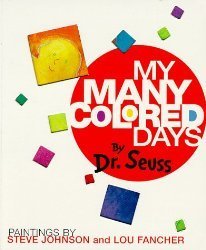

The Way I Feel by Janan Cain (board book version)


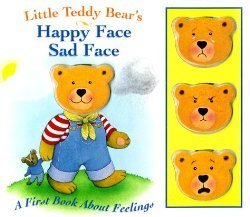

Provide alternative behavior strategies/modifications.
If your child needs to let out her frustration or anger, encourage her to do it in a physical but safe fashion. Teach her to squeeze a ball or stomp her feet.
We all get angry. Anger is a human emotion. Depending on your toddler’s receptive language, explain how you deal with anger. When I get angry, I take a deep breath, count to 10, splash water on my face, etc. If you DO lose your temper and throw an adult tantrum, fess up and apologize to your child. Say you’re sorry and acknowledge that you handled the situation poorly. Yes, you can do this even if your little one is not yet talking.
Reduce the pressure when trying to have your toddler to communicate!
I will be addressing this topic in my next post, so please stay tuned!
Additional Suggestions and Resources:
In the meantime, a 20 months old toddler who only has ten words is on the low end for her age. I would recommend having her evaluated by a certified and licensed speech language pathologist (SLP). You can find an ASHA certified SLP by clicking this here. Since she’s young, there’s still time for her to catch up to her peers!!
If you think you’re a parent who has lost that peaceful feeling, I highly recommend reading Dr. Laura Markham’s Peaceful Parent, Happy Kids: How to Stop Yelling and Start Connecting (please see picture in the left corner).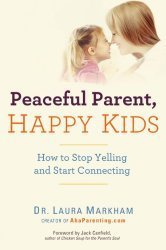

The website Zero to Three also has a wealth of information for parents of toddlers.
Occupational therapist and Yoga instructor, Lindsey Lieneck has written a fantastic article, 4 Surprising Ways to Support a Child’s Self-Regulation & Avoid Melt Down. It’s definitely worth reading.
In need of some additional free and helpful resources? Please subscribe to my newsletter. I share information and handouts exclusively with my newsletter subscribers.
If you have enjoyed reading My Toddler talks, please help spread the word. Tell your friends, write an honest review on Amazon, click the social media buttons or personally give me your feedback. I love hearing from my readers and value your input.
Thanks for reading!
References:
James, Tracy. “Do Toddler Language Skills Predict ADHD Later?” Futurity, 23 July 2014 Web. 27 July 2014.
Oregon State University. “Over-reactive parenting linked to negative emotions and problem behavior in toddlers.” ScienceDaily. ScienceDaily, 21 February 2012.
The post My Toddler Pinches and Bites When We Try to Get Her To Talk appeared first on My Toddler Talks.
My Toddler Pinches and Bites When We Try to Get her To Talk
My Toddler Pinches and Bites When We Try to Get Her to Talk.
Photo Credit: bradleygee
Several posts back I wrote:
Why does my Toddler Pull and Point But Not Talk? and 8 Ways to Get Your Toddler to Communicate
These two posts were in response to an email from a My Toddler Talks reader asking how to encourage her toddler to communicate with words rather than pulling and pointing.
A few weeks ago, another My Toddler Talks reader emailed with the following question:
“We have two children, a 3.5 year old boy and a 20 month old girl. We did not have any speech issues with our son, however our daughter is not speaking as much as we believe she should be able to at this point. She has maybe 10 words. She will resort to biting or pinching at times if she becomes frustrated. I really want to be proactive about this. Do you have any suggestions or resources?”
In this post, I’m going to address:
Why biting, pinching, hitting and more challenging behaviors occur
Give strategies to help replace these behaviors
Share some resources
In NEXT month’s post, I’ll share:
How to decrease pressure to reduce frustration while simultaneously encouraging communication
Here we go.
Think and ask yourself – What triggered the biting and pinching? Knowing the trigger will help you, the parent or clinician, modify your own behavior. Toddlers who cannot communicate their needs and wants resort to biting, pinching, hitting, and lashing out because they are frustrated and don’t know what to do. Many of these aggressive behaviors are pretty instinctive. Young children (sometimes even adults) demonstrate such behaviors because they can’t yet control their emotions. Therefore, it helps to know the trigger.
Perhaps the demands or expectations placed on her were too high?
Perhaps she was asked to do something in front of others and this made her feel self-conscious?
Perhaps she felt overwhelmed?
Perhaps she chose to bite or pinch as a way to avoid or escape a demanding task?
Interesting to note: Non-compliance and boundary pushing is pretty typical in toddlers. They are becoming more mobile and independent and thus feel the need to test the limits. However, children with delays or impairments tend to more frequently demonstrate adverse behaviors. Research from a recent longitudinal study on 120 toddlers reveals that poor language skills lead to later behavioral problems (James). The good news- with proper support and early intervention many toddlers CAN catch up.
Anticipate and (try to) prevent the biting and pinching.
If an upcoming task is challenging for your toddler and you expect some resistance (like biting or pinching) tell them what’s about to happen. Do this BEFORE the demanding task occurs. Also, tell them what you expect. Too often adults think that children who aren’t talking don’t understand what’s going on. Sometimes they don’t, but many times they do. If we deny a child with a language delay the chance to engage in conversation, we consequently deny giving the child a fair opportunity to know what’s going on in his world.
For instance, let’s imagine that you dread changing your toddler’s diaper because he always cries and rolls, making it a pretty unbearable task. You anticipate that it’s going to be miserable so you react with quickness, surprise, and trickery. You scoop up your child in the middle of his post poop bliss and swiftly put him down on the changing table. You do this without any warning because you think the less he knows the better. Or, maybe you think: What does it really matter? He’s going to complain anyway. I urge you to talk to him. Talk to your toddler as you would anyone else. Too often children who are not talking get spoken to the least when in fact they need it the most! You could try saying: “Georgie, I’m going to change your diaper. I know you want to play with your kitchen (yes, folks – kitchen), but first, I have to change your diaper. Please lie down. It makes mommy happy when you listen.” This leads to my next point.
Let’s face the facts – we can’t always prevent a toddler from becoming frustrated. He may be tired, in pain, hot, hungry, and not have the words or know how to express himself. However, we can gently but firmly tell the child – “No biting. Biting hurts.” Talk at a level your child understands. If necessary, repeat yourself. I would also use the same key phrase each time that defiant behavior occurs.
If you find that the biting behavior (or other adverse behaviors) is on the rise, perhaps you need to reassess your child’s daily routines? Are they predictable and consistent? In My Toddler Talks, I write how important routines are for toddlers. I also write about it here.
Control your own reactions.How do you respond when your child bites or pinches? Are you quick to yell? Do you get angry? Do you over-react? Recent research indicates that parents who over-react and are quick to become angry are more likely to have toddlers who act out and become easily distressed.Shannon Lipscomb, an assistant professor of human development and family sciences at OSU-Cascades states the following:
“Parents’ ability to regulate themselves and to remain firm, confident and not over-react is a key way they can help their children to modify their behavior,” she said. “You set the example as a parent in your own emotions and reactions.” (“Over-reactive parenting linked to negative emotions and problem behavior in toddlers”)
If we can’t regulate our own feelings actions, how can we expect this from our children?
Give words to help them self-regulate. Language helps us to regulate our thoughts and emotions. I’m going to repeat that – Language helps us to regulate our thoughts and emotions. The results from the longitudinal study “…suggest that language skill predicted growth in self-regulation, and self-regulation, in turn, predicted behavioral adjustment.” (James)
When your child has a meltdown or becomes frustrated, provide words to help her know how she feels. If appropriate you could say, “You’re kicking and screaming. You seem/look ________ (fill-in the perceived feeling- sad, angry, scared, etc)”.
Read books about feelings and connect those feelings to real life situations. These are some of my favorite feelings books for toddlers:
How Does Baby Feel by Karen Katz


My Many Colored Days by Dr. Seuss (board book version)


The Way I Feel by Janan Cain (board book version)


Provide alternative behavior strategies/modifications.
If your child needs to let out her frustration or anger, encourage her to do it in a physical but safe fashion. Teach her to squeeze a ball or stomp her feet.
We all get angry. Anger is a human emotion. Depending on your toddler’s receptive language, explain how you deal with anger. When I get angry, I take a deep breath, count to 10, splash water on my face, etc. If you DO lose your temper and throw an adult tantrum, fess up and apologize to your child. Say you’re sorry and acknowledge that you handled the situation poorly. Yes, you can do this even if your little one is not yet talking.
Reduce the pressure when trying to have your toddler to communicate!
I will be addressing this topic in my next post, so please stay tuned!
Additional Suggestions and Resources:
In the meantime, a 20 months old toddler who only has ten words is on the low end for her age. I would recommend having her evaluated by a certified and licensed speech language pathologist (SLP). You can find an ASHA certified SLP by clicking this here. Since she’s young, there’s still time for her to catch up to her peers!!
If you think you’re a parent who has lost that peaceful feeling, I highly recommend reading Dr. Laura Markham’s Peaceful Parent, Happy Kids: How to Stop Yelling and Start Connecting (please see picture in the left corner).

The website Zero to Three also has a wealth of information for parents of toddlers.
Occupational therapist and Yoga instructor, Lindsey Lieneck has written a fantastic article, 4 Surprising Ways to Support a Child’s Self-Regulation & Avoid Melt Down. It’s definitely worth reading.
In need of some additional free and helpful resources? Please subscribe to my newsletter. I share information and handouts exclusively with my newsletter subscribers.
If you have enjoyed reading My Toddler talks, please help spread the word. Tell your friends, write an honest review on Amazon, click the social media buttons or personally give me your feedback. I love hearing from my readers and value your input.
Thanks for reading!
References:
James, Tracy. “Do Toddler Language Skills Predict ADHD Later?” Futurity, 23 July 2014 Web. 27 July 2014.
Oregon State University. “Over-reactive parenting linked to negative emotions and problem behavior in toddlers.” ScienceDaily. ScienceDaily, 21 February 2012.
The post My Toddler Pinches and Bites When We Try to Get her To Talk appeared first on My Toddler Talks.
June 28, 2014
A Toddler Summer Book to Build Language: At the Beach
A Toddler Summer Book to Build Language: At the Beach
Since I was a little girl every summer, my family and I vacationed at the Jersey shore. Now that my daughter is almost 2 years old, I have been particularly excited to bring her to the beach so she can experience the magic and wonder of the seashore.
For the past few weeks leading up to our weekend trips to the shore, I have been reading her this charming 24 page paperback book:
Yes, a paperback book! Unfortunately, this book is NOT available as a board book although a hardcover version
has recently been released. I often recommend board books for little ones, especially if they’re turning pages and “reading” to themselves. However, when I read this book to my daughter I usually read it before her nap or bedtime, so I’m the one turning the pages and handling the book. At least for now, this paperback has NOT been destroyed by my precious one’s curious little fingers. Keep that in mind if you choose to buy this wonderful book.
Kerri enjoyed having At the Beach read to her, but she was pretty quiet during our first few reading sessions. Every once in a while she would point to the birds (seagulls and sandpipers) and say “birds” but that was pretty much it. Despite this, she always wanted me to read it multiple times and often requested it before going to sleep. I wondered how much she really understood or took away from our readings of At the Beach, because she didn’t yet have any firsthand experience with many of the things in the book (seaweed, lifeguards, waves, sandcastles, seashells, etc.). Yet, she was obviously fascinated because she would look at illustrations with great interest and ask, “What’s that?” Nevertheless, I kept reading and re-reading this book day in and day out.
About two weeks ago, we made our first trip to the Jersey shore. I made sure to connect everything we talked and read about from At the Beach to what she experienced firsthand.
What do you think happened? She said two new words “beach” and “waves”.
That night after having a wonderful day at the beach, she even repeated those words during our book reading and became really excited when she realized that we’d done some of the same activities that were in At the Beach!
This week we spent a few more days down the shore and now she’s saying even more words related to At the Beach, such as “boat”, “pour”, “dump it”, and “peach”.
Interestingly, for several weeks leading up to Memorial Day, I was searching high and low for a summer collection of toddler level beach books that I could read to my daughter and clients. There are many wonderful summer books (concept ones and narratives) for preschoolers, but I struggled to find ones that were cute and appropriate for toddlers. At the Beach fit the bill. Am I claiming that it will get your toddler talking? No, of course not. But I want to stress the following two points when it comes to book reading with your toddler:
Read and re-read the same books. Research shows that toddlers and preschoolers learn new words faster when the same books are repeatedly read to them. If your toddler likes a book and wants you to re-read it, then do it. With each re-read your child’s understanding is growing. He or she is also picking up on something different each time. Ever re-watch a movie or TV show and realize that you missed something the first time you saw it?
Children learn via first-hand experience. Experiencing the ocean and reading about the ocean are two separate things. Kerri may have been so intrigued with the beach and the waves (hence wanting to say them) because she saw and felt them first-hand. She was pulled by the undertow, gently and not so gently pushed by the waves and sprayed by the shore break. Reading about the ocean (or learning about other concepts such as fast vs slow, rough vs smooth) cannot be learned by reading about it. BUT – and this is important – books can introduce and reinforce certain concepts and help children to relive past events and replay precious memories. How often do Kerri and I read At the Beach only to have her pretend to bite into a peach, shout “beach” with excitement and talk about her beach related experiences?
If the beach is not accessible for you or if you don’t like the beach, ponder this:
What is accessible to you and your child?
A sprinkler, a pool, a lake…
How can that special experience or shared activity create memories that can be relived and talked about?
Once you find a shared interest or family activity, find a book (or create one with photos!) that can compliment the experience.
What are your summer plans? How can you prepare your child for his or her summer trip or vacation by repeatedly reading a relevant book and making connections?
In need of some additional free and helpful resources? Please subscribe to my newsletter. I share information and handouts exclusively with my newsletter subscribers.
If you have enjoyed reading My Toddler talks, please help spread the word. Tell your friends, write an honest review on Amazon, click the social media buttons or personally give me your feedback. I love hearing from my readers and value your input.
Thanks for reading!
The post A Toddler Summer Book to Build Language: At the Beach appeared first on My Toddler Talks.
June 27, 2014
A Toddler Summer Book to Build Language: At the Beach
Sin...
A Toddler Summer Book to Build Language: At the Beach
Since I was a little girl every summer, my family and I have vacationed at the Jersey shore. Now that my daughter is almost 2 years old, I’ve been particularly excited to bring her to the beach so she can experience the magic and wonder of the seashore.
For the past few weeks leading up to our weekend trips to the shore, I’ve been repeatedly reading her this charming 24 page paperback book:
Side note – this book is actually a paperback! Unfortunately, it’s NOT available as a board book although a hardcover version has recently been released. I often recommend board books for little ones, especially if they’re turning pages and “reading” to themselves. However, when I read this book to my daughter I usually read it before her nap or bedtime, so I’m the one turning the pages and handling the book. At least for now, this paperback has NOT been destroyed by my precious one’s curious little fingers. Keep that in mind if you choose to buy this wonderful book.
Kerri enjoyed having At the Beach read to her, but she was pretty quiet during our first few reading sessions. Every once in a while she would point to the birds (seagulls and sandpipers) and say “birds” but that was pretty much it. Despite this, she always wanted me to read it multiple times and often requested it before going to sleep. I wondered how much she really understood or took away from our readings of At the Beach, because she didn’t have any firsthand experience with many of the things in the book (seaweed, lifeguards, waves, sandcastles, seashells, etc.). Yet, she was obviously fascinated because she would look at illustrations with great interest and ask, “What’s that?” Nevertheless, I kept reading and re-reading this book day in and day out.
About two weeks ago, we made our first trip to the Jersey shore. I made sure to connect everything we talked and read about from At the Beach to what she experienced firsthand.
And, what do you think happened? She said two new words “beach” and “waves”.
That night after having a wonderful day at the beach, she even repeated those words during our book reading and became really excited when she realized that we’d done some of the same activities that were in At the Beach!
This week we spent a few more days down the shore and now she’s saying even more words related to At the Beach, such as “boat”, “pour”, “dump it”, and “peach”.
You want to know what’s funny? For several weeks leading up to Memorial Day, I was searching high and low for a summer collection of toddler level books that I could read to my daughter and clients. I was particularly interested in ones about the beach. There are many wonderful summer books (concept ones and narratives) for preschoolers, but I struggled to find ones that were cute and relatable for toddlers. At the Beach fit the bill. Now, am I claiming that it will get your toddler talking? No, of course not, but I want to stress the following two points when it comes to book reading with your toddler:
Read and re-read the same books. Research shows that toddlers and preschoolers learn new words faster when the same books are repeatedly read to them. If your toddler likes a book and wants you to re-read it, then do it. With each re-read your child’s understanding is growing. He or she is also picking up on something different each time. Ever re-watch a movie or TV show and realize that you missed something the first time you saw it?
Children learn via first-hand experience. Experiencing the ocean and reading about the ocean are two separate things. Kerri may have been so intrigued with the beach and the waves (hence wanting to say them) because she saw and felt them first-hand. She was pulled by the undertoe, gently and not so gently pushed by the waves and sprayed by the shore break. Reading about the ocean (or learning about other concepts such as fast vs slow, rough vs smooth) cannot be learned from reading about it. BUT – and this is important – books can introduce and reinforce certain concepts and help children to relive past events and replay precious memories. How often do Kerri and I read At the Beach only to have her pretend to bite into a peach, shout “beach” with excitement and talk about her beach related experiences?
If the beach is not accessible for you or if you don’t like the beach, ponder this:
What is accessible to you and your child?
A sprinkler, a pool, a lake…
How can that experience or activity create shared memories that can be relived and talked about?
Once you find a shared interest or family activity, find a book (or create one with photos!) that can compliment the experience.
What are your summer plans? How can you prepare your child for his or her summer trip or vacation by repeatedly reading a special book and making connections?
The post appeared first on My Toddler Talks.
June 3, 2014
7 Ways to Get Your Village on Board to Promote Your Toddler’s Language Development
7 Ways to Get Your Village on Board to Promote Your Toddler’s Language Development
If you’ve been reading my blog or have read My Toddler Talks, you know that I value routines and consistency. Toddlers need consistency and familiar routines to feel safe and to thrive. To further encourage your toddler’s language development, consistency amongst the village is also needed. Since these trusted members are helping to raise and care for your precious little one(s), they should also know how to encourage your toddler’s communication.
If grandpa, who babysits in the afternoon, immediately gives Joey what he wants each time he utters, “ah ah”, then he probably needs to be instructed on what he should do instead.
If your babysitter, who watches Ava twice a week, struggles to understand her, she needs to know how best to communicate with Ava. For instance, Ava may communicate best when you pause and give choices, rather than ask complicated open-ended questions.
BUT – How can you share information and suggestions without alienating your village? How can you effectively communicate all the tips and tricks your child’s speech therapist shares with you or the ones you’ve read in My Toddler Talks?
Since I use my village to support my own toddler’s language development, I had the SAME questions and concerns. Before I wrote this post, I did some serious brainstorming and then implemented my own recommendations. Sometimes things didn’t always go to plan, so I made some tweaks. I also interviewed two amazing mothers of children with speech delays, Meg M. and Rebecca Ishum, because I didn’t just want to share my own advice. How many times have you read books, articles, and blog posts written by “experts” who seem to be a little out of touch with the everyday demands of parenting or just life in general? I wanted to share real perspectives.
Meg M. is the mother of two young boys, one who just turned 3 years old and has autism. She has an incredible blog, My So-Called Blog, where she reveals her joys, adventures, and challenges of being a mother, how she came to accept her child’s diagnosis of autism, as well as sharing much needed inspiration and encouragement. I also interviewed Rebecca Ishum, creator of A Beautiful Ruckus, and the mother of adorable quadruplets all who receive or have received speech therapy. She chronicles the amazing development of her quad and shares how she manages a busy household, coordinates therapies, survives mealtime and gives many helpful tips and tricks on how to take care of multiples.
These two mothers are blessed to have the support of fantastic villages. Their villages consist of family, friends, therapists, teachers, and in Rebecca’s case, her church community. I asked Meg and Rebecca open-ended questions on HOW their village lends a hand in supporting their children’s language development and communication. Their thoughtful responses are intermingled throughout my post.
I also want to add, that in the process of trying out my own suggestions, I learned a valuable lesson in the process…but, wait. I’ll share it at the end.
Let’s get started.
Here are my 7 Ways to Get Your Village on Board to Help Support Your Toddler’s Language Development.:
1. Increase awareness in your village.
In my previous post, I shared this tip as a teaser. First off, your village needs to become mindful of your toddler’s language and communication. Do this by planting the seed – ask questions and make comments. I do this with my daughter’s babysitter and daycare teacher (who, by the way, are wonderful). I simply ask: “Have you noticed any new words or sounds?” Then I ask it again and again. But, I’m mindful not to be *too* annoying. I do it enough so they know it’s something I’m concerned about and that it piques their interest. Here are some other things I mentioned in my previous post:
Ask your village, “What have you found helps Janice to communicate? Others may notice things you haven’t and their insight is valuable. Or, ask, “What do you think it means when Henry does this or does that?” Sometimes just asking thoughtful questions helps others become more mindful of certain behaviors or situations. Or, remark, “I’ve noticed that whenever I do X, Mary is more likely to do Y. Have you seen that too?” Increasing awareness is the one of the first steps needed to make change, to break old habits and to form new ones.
2. Encourage open and honest communication.
The best way to have and maintain a mutually respectful relationship is to encourage open and honest communication. This sounds like a lot of fluff. But, think about it. Do you ask your village for input and feedback? Do you accept their opinions, even if they’re different from yours? Rebecca strives for open and honest communication with her village. She states, “Communication is one of the most important tools in your tool box. Don’t be afraid to ask others for what you need, gently guide them in the best ways to help your kids, and update them regularly. Most people who aren’t in a situation like this don’t realize the ins and outs, and honestly, I think it scares them a bit. Be open to questions, freely share the answers, and that transparency will ultimately benefit your child the most.” I love that Rebecca mentioned transparency in her response. Transparency is so important to the health and well-being of any relationship. If you’re not being transparent with your village, then what are you being? I also love how she pointed out, “I think it scares them a bit”. I remember the uncertainty and consequent anxiety I had in graduate school when I was about to treat my first client in clinic. Of course I did my research and had a game plan, but I was still scared because I really had no idea what I was doing. Fortunately, I had amazing clinic supervisors at Montclair State University. They openly and honestly communicated with me. They didn’t just tell me what to do (because rarely does that work when learning a new skill) they asked thoughtful questions to encouraged dialogue and self-reflection. This leads to my next point…
3. P rovide your village with positive and specific feedback.
Recently, I read an insightful article in Inc. Magazine entitled (or titled) 17 Things Happy People Say Every Day. I liked it so much that I printed it out and posted it on my fridge. Author, Bill Murphy Jr. states:
“ Your words are among your greatest tools, so you can have an outsize effect on others simply by thinking about what you say every day and making an effort to be both positive and sincere. There are certain inspiring things that truly happy people find themselves saying to others all the time. Try making an effort to say a few of these every day for a week. You’ll be amazed at how the positivity you create improves your happiness.”
I want a happy village. I immediately thought about how I could use Murphy’s statements when communicating tips and suggestions with my village or when providing feedback. I found the following statements to be most beneficial and effective in expressing my appreciation but also a fantastic way to carefully share tips and suggestions without hurting feelings or stepping on anyone’s toes:
“You might not realize this, but…” Then, I fill in how they used a technique or did something to help Kerrigan communicate. This is also related to also increasing awareness.
“You really impress me when…” Then, I fill in a specific action they performed that helped Kerri communicate.
“I’d like to hear your thoughts about…” Who doesn’t feel at least somewhat honored and more appreciated when asked their opinion or feedback? I know I do! Plus, you might learn something in the meantime.
What other positive statements can you say to spread happiness and encourage open and honest communication and provide positive feedback and reinforcement – all at the same time? Please share and comment below. To read Murphy’s article, click here.
4. Explain how your child communicates.
Even a child who is not yet communicating with words, (FYI – I like to use the term preverbal rather than non-verbal) has some mode of communication. It may not be functional. It may not be intentional. It may not be easily understood. But, it’s there. A majority of times, perceptive parents can understand what their child wants or needs even if they’re not yet talking. If your child communicates in an unusual or unique way, share that vital information with your village. For instance, tell them that when Henry opens and closes his hands it means he wants to listen to his favorite song, Twinkle Twinkle Little Star. Whey they are privy to such information, they can more meaningfully and purposefully respond.
As mentioned previously, Meg’s 3 year old son, Finn has autism, but he also has childhood apraxia of speech. According to Meg, Finn communicates by making “a lot of happy sounds” and also using a PECS board, particularly at school. Meg encourages everyone to respond to these sounds with verbal praise and reinforcement because she wants to ensure that some older members of her family know that “these squeals and squeaks are not “whining” but the only way Finn can use his voice right now.” I love that Meg advocates for her child’s budding communication skills. Finn needs encouragement to keep making his happy sounds so that they can eventually grow into happy words and phrases!
5. Share language development tips and strategies.
Before I share my suggestions on how to share tips with your village, I want you to brainstorm. Ask yourself – what’s the most efficient and effective way for me to share tips – without driving myself crazy? Meg and Rebecca have much gratitude and appreciation for their villages but both would admit that getting everyone on the same page can be quite a task. So, how can you do it?
Everyone’s village is different so what you decide to do is personal. I would recommend not inundating newly minted village members with tips and strategies all at once. First, build their awareness by following tip #1, next implement tip #2 and explain how your child communicates and then slowly start sharing tips and strategies (don’t forget to incorporate the techniques from tip #3). I think the best way to share a tip is in an intimate one-on-one setting. Since my village is small compared to others, I can afford the time to do this. I personally show how to perform a strategy and then have the village member recap and do it themselves. We’ve had to do this Kerrigan’s eating and feeding schedule. Once all my members have been introduced to a strategy or technique, then I write it down and post it on the fridge or push pin board. I also recommend this with my clients.
How you communicate tips and strategies will change as your child/children age and mature. This was the case for Rebecca:
“When the kids were itty-bitty, it was absolutely imperative that everyone followed the guidelines for our kids. Things like teaching them to swallow and eat, stretching our son’s neck to help with torticollis, and dealing with the monitors and oxygen tanks required that our helpers be extra vigilant around our kids. We had signs posted everywhere with directions, timelines, and measurements. We also made sure that we walked each and every person through the procedures. Often, they were really nervous walking into our special needs quadruplet situation, but those few minutes spent giving them the tour, explaining everything slowly, and answering questions, quickly helped to put them at ease. It was time-consuming and repetitive for us, but we found that overwhelmingly, people wanted to help us help our kids, and that was the best way to start. What a blessing!
Here’s my list of various ways to share tips and strategies :
Explain the strategy.
Show them the strategy.
Have them perform the strategy.
Have them observe a speech therapy session.
Tell them what works for your child.
Tell them what doesn’t work for your child.
Send out a mass email with updates.
Start a blog. Interestingly, both Meg and Rebecca use blogging as a way to share updates and progress with their villages. Just something to think of…Blogging, which can be anonymous, is a wonderful way not only to decimate information but also to release pent up emotions, thoughts and frustrations.
Share a video update. This was Meg’s idea and I thought it was great!
Post reminders and guidelines. When Kerrigan was having severe stomach problems, we were diligent about posting foods that she was to avoid. We displayed them on the fridge so that anyone at any time could easily and quickly read it.
Write a manual or keep a journal. While Rebecca no longer has signs posted around the house, she has written an “Ishum Quads Manual”. Rebecca explains, “In it, I cover everything from how to calm our hyper-sensitive child, to who gets which loveys, to how to work the TV/DVD remotes. It’s primarily a resource for when we leave our kids with others, but several friends have read through it just to make sure they know everything that is going on.” For children with severe speech and language delays, writing a “manual” may prevent having to repeat yourself ten times and also give you some peace of mind. Or, you could keep a journal that everyone can access and write in.
Have an additional tip? Please share in the comments.
6. Be flexible.
I have to be totally honest here. I’ve never considered myself to be a controlling type person. Then, I had a daughter. And, not only did I have a child, I had a child who didn’t sleep or eat because of reflux and food sensitivities. As a result, we didn’t sleep. It’s not pretty when everyone’s sleep deprived! Luckily, she’s gotten much better. I thought if I could control every little thing and everyone in my village, then my daughter would eat and sleep. That didn’t really work though. Not only will you go crazy trying to control every little detail, interaction, situation, or member, you’ll also alienate your village. Many of my clients and former clients, especially those whose children have autism, have almost burnt out trying to control and constantly teach others how to interact with their child. Here, Meg explains her own situation:
“It can be extremely nerve wracking for both of us when we are separated, because I understand him completely, whereas other people less familiar with him may not. Even though he doesn’t speak, he communicates with me very clearly by using leading and gestures. He is very intentional, and when someone doesn’t understand what he wants it can be frustrating. I have learned over time that I can’t control all of these interactions and that I can’t control how family, friends, and caregivers communicate with Finn. I have learned that there is no “right way”, and it’s important for Finn to learn to communicate in a variety of ways with a variety of people, not just me. …It’s also important for me, like I mentioned before, to be laid back about Finn’s interactions with others. If at the root of it everyone loves him and treats him with respect, then I have found that Finn feels confident enough in himself to communicate with all kinds of other people and get his point across.”
Can you relate to Meg’s situation? I certainly can. And, I know many other parents who can too.
7. Respect and appreciate your village
In today’s society we seem to value our worth by our “busyness”. A few weeks ago I read the following statement shared by Janet Lansbury of Elevating Child Care, “Stop the glorification of busy.” I have to shamefully admit, for a majority of my adult life, I have glorified busy. I find that when you glorify busy though, you appreciate your time with others less. You rush through interactions and do everything in haste because you’re always thinking of the next thing to do. You don’t have time to appreciate because you’re too busy. As a result, relationships and friendships suffer. There are many ways to respect and appreciate your village. How do you or will you respect and appreciate your village?
In closing, I want to thank Meg and Rebecca for so graciously answering my questions and sharing their experiences. They have amazing villages but more importantly they are amazing parents. Interviewing these mothers helps me to remember that at the end of the day, parental involvement is the most important factor in your child’s development. Rebecca emphasizes this too:
“I think the best advice that I can give to parents who have kids with developmental delays is this: You are your kids best advocate. No one knows them and loves them more than you!”
PS – Feel free to share this post with your village!
In need of some additional free and helpful resources? Please subscribe to my newsletter. I share information and handouts exclusively with my newsletter subscribers.
If you have enjoyed reading My Toddler talks, please help spread the word. Tell your friends, write an honest review on Amazon, click the social media buttons or personally give me your feedback. I love hearing from my readers and value your input.
Thanks for reading!
The post 7 Ways to Get Your Village on Board to Promote Your Toddler’s Language Development appeared first on My Toddler Talks.
April 30, 2014
It Takes a Village: Getting Everyone on Board to Support Your Toddler’s Language
It Takes a Village: Getting Everyone on Board to Support your Toddler’s Language
“It’s takes a village to raise a child.”
Having an active toddler of my own and the support of a several key people, I agree with this proverb. I would also assert that it takes a village to develop a child’s language skills. Before I tell you HOW to use your village to encourage your child’s language development, I want to stress WHY parents need the support of a village.
Photo Credit: molly.layde
Having trusted help is good for your child and it’s good for you.
If you don’t have any help caring for your child, I bet you’re exhausted. I see clients 3 days a week. In between my daughter’s naps and after she goes to sleep, I squeeze in time for blogging and writing. When I work, Kerrigan’s either at daycare (she attends 3 hours in the morning), or with my mom or my lovely next door neighbor. My in-laws also lend a hand, when they come in from out of town. I’m fortunate to have amazing help.
Exposing your child to the love and care of trusted adults helps him or her to develop healthy emotional connections. According to Dr. Edward Hallowell, a child psychiatrist and author of The Childhood Roots to Adult Happiness, “A connected childhood is the key to happiness”. The more social connections and bonds your child has, the happier he or she will be. I agree with Dr. Hallowell because I see it with my own daughter. Her eyes light up when she sees grandma and a huge smile forms when she sees her favorite Uncle or dedicated babysitter. When we pull into the school’s parking lot, Kerrigan cheers and says “Yay! School”!
Kerrigan also learns from her village members. It’s amazing what she picks up when she’s not with me. My mother-in-law (aka mom-mom) introduced her to a game we call, “Horsie”. She sits on mom-mom’s leg and she pumps it up and down, while clicking her tongue to sound like a horse trotting. Kerrigan thinks she’s riding a horse and loves it! Even though I do lots with Kerrigan, I haven’t thought to do that with her. I turned “Horsie” into a way to promote her language skills by encouraging her to say “horsie” instead of just pointing to mom-mom’s legs for a ride. Now, she’ll say “horsie” when touching my legs AND make the trotting sounds with her tongue.
Social connectedness and support from family and friends also benefits parents. Caring and raising your child is very rewarding but it’s STRESSFUL. Without any help or access to social outlets, burn out rate is high. Being connected to others allows us to take a break and to vent. It also decreases feelings of isolation.
Why am I writing about this topic? Two reasons.
Firstly, I have encountered many parents, several having children with delays, who worry that the family member, babysitter, or other hired help will not do things the “right way”. Instead of getting help, these parents attempt to do everything by themselves. Some will not even accept or trust the support of a spouse. I have also known families that prefer not to share worries or disclose information about their child’s development to family members and friends. They have consciously made efforts not to tell anyone that their child is receiving speech therapy. This is TOTALLY understandable.
If you find yourself in either situation and you’re feeling overwhelmed and anxious, I recommend building your village sooner than later to prevent burnout. Life is too short to carry the weight of the world on your shoulders. If you decide not to disclose information about your child’s development to family and friends, then I might assume they will not be part of the village that assists in developing his or her language skills? If so, that’s fine. With a little creativity and brainstorming, there are other ways to build a village by using outside support (babysitters, daycare, support groups, virtual forums, mommy groups, etc).
Secondly, if you’re fortunate to have a village and you’re trying to promote your toddler’s language, everyone needs to know what to do, how to do it and when to do it. Working together will ensure more efficient and effective progress.
Sound complicated? Well, it can be. But, it’s worth making the effort. Stay tuned – my next post is HOW to get your village on board to promote language development.
Sorry, for being such a tease. I’ll share one quick tip.
Increase awareness. Talk about talking. You want your village to be mindful of your toddler’s communication. Plant the seed by asking questions and seeking their advice or input. Ask your village, “What have you found helps Janice to communicate? Others may notice things you haven’t and their insight is valuable. Or, ask, “What do you think it means when Henry does this or does that?” Sometimes just asking thoughtful questions helps others become more mindful of certain behaviors or situations. Or, remark, “I’ve noticed that whenever I do X, Mary is more likely to do Y. Have you seen that too?” Increasing awareness is the one of the first steps needed to make change, to break old habits and to form new ones.
More tips to come in the next post.
How have you gotten your village on board? Feel free to share tips.
In need of some additional free and helpful resources? Please subscribe to my newsletter. I share information and handouts exclusively with my newsletter subscribers.
If you have enjoyed reading My Toddler talks, please help spread the word. Tell your friends, write an honest review on Amazon, click the social media buttons or personally give me your feedback. I love hearing from my readers and value your input. YOU are the reason why I devote so much time to perfecting my craft. Thank you.
Thanks for reading!
The post It Takes a Village: Getting Everyone on Board to Support Your Toddler’s Language appeared first on My Toddler Talks.
March 24, 2014
5 Spring Books for Toddlers
5 Spring Books for Toddlers
I don’t know about you, but I’m super excited for spring. Since it’s been a VERY long winter for many of us, I’ve decided to write a post on some of my favorite spring books for toddlers. Reading tips and extension activities are included.
Welcome Spring by Little Scholastic

Welcome Spring (Little Scholastic) ">
">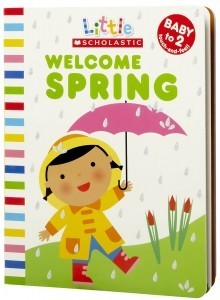
This is a simple spring time book. Its illustrations are bright, clean and cheery. Since it’s a touch and feel book your toddler can interact with different textures like satin, felt, and some type of rubber like material. I particularly like how this book shows how a young child experiences spring through her senses because it makes it easy to target verbs like smell, touch, hear, and see.
Since it’s a fairly basic book and the lines are short it’s perfect for a younger toddler whose attention span may be shorter. Although the norms vary, toddlers between the ages of 16 and 19 months typically have an attention span that lasts 2 -3 minutes, toddlers aged 20 to 24 months can attend for about 3 to 6 minutes, and those 25 to 36 months old can focus on one thing for about 5 to 8 minutes.
Reading Tip:
Act out the senses! On the first page, there’s a picture of a young girl smelling flowers growing in the yard. After reading the line “Smell the flowers growing in the yard.” – Pretend to smell the flower on the page. Then, encourage your child to smell the flower on the page. If you want to take it a step further, so you actually smell something, you could sprinkle the satin flower in the book with a hypoallergenic, non-toxic perfume, body oil, a scented spray etc.
Extension Tip:
Take the book with you and go outside on a nature walk. Smell the flowers in your garden (if you have any yet!) and listen to birds chirping (place your hand to your ear and encourage your toddler to do the same). Before toddlers imitate speech, they try to imitate gestures and body movements. Performing these actions is a precursor to verbal imitation.
Baby Loves Spring! byKaren Katz

Baby Loves Spring!: A Karen Katz Lift-the-Flap Book (Karen Katz Lift-the-Flap Books) ">
">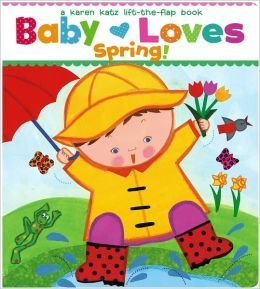
Who doesn’t love a little Karen Katz? In Katz’ classic child-like and folksy artistic style, she captures a child’s innate curiosity by having them reveal the answers to straightforward what questions under large flaps in the book.
Reading Tip:
Katz uses some lively verbs like tweeting, squiggling, and fluttering. They can easily be acted out like in the same way as explained in reading tip above. Or, after your child becomes familiar with the book, try having your toddler respond to the What questions – by giving a sign or saying a sound, word, or phrase. Or, focus on the springtime clothes the baby is wearing (hat, jacket (or raincoat), boots (or goulashes – challenge word!) and umbrella.
Extension Tip:
It rains a lot in the spring. Here in the Garden State, we average about 4.13 inches of rain per spring so we’re pretty familiar with umbrellas, raincoats, and goulashes. If it’s drizzling or raining lightly dress your toddler in his or her raingear and head outside. Jump in puddles, pop open an umbrella, find worms, feel raindrops fall into your hands, etc. Remember toddlers learn from hands on experience. FYI – Please use common sense and do not bring your child out if he is sick or ill. I do not want your child to get sick!
Wake Up! Wake Up! by Nancy Davis

Wake Up! Wake Up!: A Springtime Lift-the-Flap Book (Springtime Life-The-Flap Books) ">
">
This is a cute lift the flap book. A friendly little ladybug wakes up from a long winter’s nap and realizes that it’s springtime. She then wakes up all her little friends including a bunny, a chick, a butterfly, and a tulip. The ladybug repeats the phrase, “Wake up! Wake up!” and proceeds to tell her friends that “The snow has melted, the sun is shining, and the flowers are blooming.” Repetition is important to toddlers and helps with language development; there’s a fair amount of it in this book.
Reading Tip:
If your toddler is starting to imitate sounds or words, encourage him or her to imitate the phrase “Wake up” BEFORE lifting the flap. Sometimes toddlers need a little (repeat LITTLE) pressure to increase verbal output. Instruct your toddler to say “wake up” while holding the flap down with your finger. If he or she understands a little sequencing and cause and effect you could tell him or her, “First say wake up and then lift the flap.” That seems to work for my own daughter.
Extension Tip:
If your toddler has any stuffed animals like those in the book, pretend they are sleeping and then wake them up with a gentle pat or shake while saying “Wake up”.
Ten Little Ladybugs by Melanie Gerth

I’ll be honest, when I first bought this book at a garage sale many moons ago, I didn’t really like it. In fact, it sat in my basement collecting dust for years. Then, I had K and took it out to try sometime around her 1st birthday. Guess what? She loved it! She enjoyed labeling the softly painted bugs and animals, touching the plastic 3d ladybugs, pointing to the numbers, and listening to the rhythmic repetitive lines. Gerth was clearly thinking of the adult reader in mind when writing this story as well. It starts with ten little ladybugs sitting on a vine. Then as larger animals and bugs approach, the number of ladybugs gradually dwindle to one (gee, I wonder why?).Finally, they all magically reappear on the last page and live happily ever after with the larger animals and bugs. My daughter nor have any of the toddlers I read this book to have ever asked what happened to the ladybugs in between, so I don’t think you have to worry about explaining that to your toddler.
Reading Tip:
Sing this book! Even though I don’t directly focus on counting, it’s fun to put your fingers up and count as you sing the lines in this book. Once your child becomes familiar with the book you could sing the lines up to the point when a larger animal or bug enter the story. For instance, when reading “Ten little ladybugs sitting on a vine. Along came a ______” (Pause, point to the picture of the animal or bug and see if you toddler will attempt to say it). In My Toddler Talks, I call this the Fill in the Blank technique. It tends to work best with toddlers who have started talking, are familiar with the phrase and are imitating words.
Extension Tip:
Color some pictures of ladybugs, bumblebees, fish, frogs, and more bugs and animals!
Mouse’s First Spring by Lauren Thompson

Mouse's First Spring (Classic Board Books) ">
">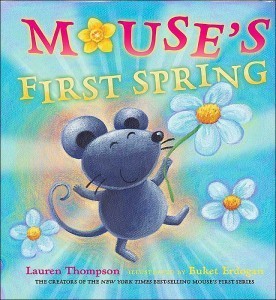
This is the longest book of the 5 and probably best suited for an older toddler or one who has stronger attention skills. A mouse and his mommy go outside to discover that spring has sprung. The lines are longer and the vocabulary is very descriptive and playful (e.g. glittery and flittery, fluttery and buttery) and there’s lots of onomatopoeia and repetitive lines (“What can it be wondered Mouse?”). If you’ve read any of the books in the Mouse’s First series, you’ll be familiar with author, Lauren Thompson’s style and format.
Reading Tip:
I like to scratch my head or rub my chin when reading the line “What can it be wondered Mouse?” My toddlers usually laugh, try gesturing themselves and or answer the question by pointing to the picture or naming the revealed insect or animal. Since this book is good for toddlers who are starting to combine words, you can work on extending and expanding their two word combinations by using expansions and extensions. These tips are included in My Toddler Talks, but click here if you’re interested in learning more. Since there are many prepositional phrases throughout the book (in the grass, on a stem, under a leaf), you can also work on your toddler’s ability to follow simple commands related to the prepositions in, on, and under.
Extension Tip:
Typically, between the ages of 25 and 36 months old, toddlers begin saying several different prepositions. If your toddler is not, try increasing their understanding of the words by following directions and or locating objects. This is because toddlers need to understand words or concepts BEFORE they can start saying them. Remember understanding comes before production. Go outside with a few of your toddler’s toy animals, perhaps those that are featured in Thompson’s book and hide them (don’t make it too hard though!). Encourage them to find them by giving directions using the prepositions in, on, under, etc. If your toddler struggles with this task, then show them where it is while saying the prepositional phrase (“It’s on the deck, Sam” or “It’s in the flower pot”).
As always, I hope you found this post helpful. Does your toddler have a favorite spring time book? If so, please include in the comments.
If you’re in need of some more tips please read my guest post for Pediastaff entitled: How to Use Books to Improve Toddlers Communication Skills.
Happy reading!
If you’ve enjoyed this post, you may like the following:
Spring Flowers Arts and Crafts Activity for Toddlers and Preschoolers
A Cute Arts and Crafts Activity to Improve Speech and Language
The post 5 Spring Books for Toddlers appeared first on My Toddler Talks.



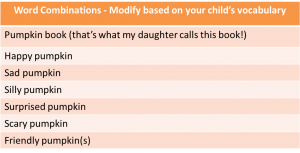
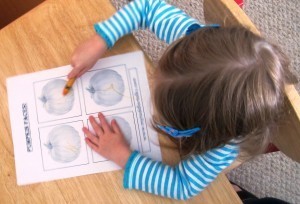
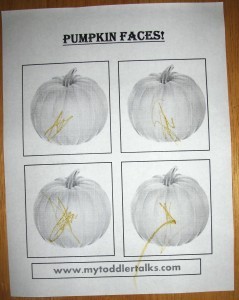








 ">
">



